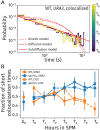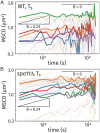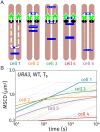Diffusion and distal linkages govern interchromosomal dynamics during meiotic prophase
- PMID: 35302885
- PMCID: PMC8944930
- DOI: 10.1073/pnas.2115883119
Diffusion and distal linkages govern interchromosomal dynamics during meiotic prophase
Abstract
SignificanceEssential for sexual reproduction, meiosis is a specialized cell division required for the production of haploid gametes. Critical to this process are the pairing, recombination, and segregation of homologous chromosomes (homologs). While pairing and recombination are linked, it is not known how many linkages are sufficient to hold homologs in proximity. Here, we reveal that random diffusion and the placement of a small number of linkages are sufficient to establish the apparent "pairing" of homologs. We also show that colocalization between any two loci is more dynamic than anticipated. Our study provides observations of live interchromosomal dynamics during meiosis and illustrates the power of combining single-cell measurements with theoretical polymer modeling.
Keywords: homologous chromosome pairing; meiosis; polymer physics; tetO/TetR-GFP.
Conflict of interest statement
The authors declare no competing interest.
Figures







Similar articles
-
Evidence that masking of synapsis imperfections counterbalances quality control to promote efficient meiosis.PLoS Genet. 2013;9(12):e1003963. doi: 10.1371/journal.pgen.1003963. Epub 2013 Dec 5. PLoS Genet. 2013. PMID: 24339786 Free PMC article.
-
Moving and stopping: Regulation of chromosome movement to promote meiotic chromosome pairing and synapsis.Nucleus. 2017 Nov 2;8(6):613-624. doi: 10.1080/19491034.2017.1358329. Epub 2017 Sep 11. Nucleus. 2017. PMID: 28892406 Free PMC article. Review.
-
Centromere pairing precedes meiotic chromosome pairing in plants.Sci China Life Sci. 2017 Nov;60(11):1197-1202. doi: 10.1007/s11427-017-9109-y. Epub 2017 Jul 26. Sci China Life Sci. 2017. PMID: 28755295 Review.
-
The dynamics of homologous chromosome pairing during male Drosophila meiosis.Curr Biol. 2002 Sep 3;12(17):1473-83. doi: 10.1016/s0960-9822(02)01090-4. Curr Biol. 2002. PMID: 12225662
-
Dynamics of homologous chromosome pairing during meiotic prophase in fission yeast.Dev Cell. 2004 Mar;6(3):329-41. doi: 10.1016/s1534-5807(04)00059-0. Dev Cell. 2004. PMID: 15030757
Cited by
-
Agent-based modeling of nuclear chromosome ensembles identifies determinants of homolog pairing during meiosis.PLoS Comput Biol. 2024 May 13;20(5):e1011416. doi: 10.1371/journal.pcbi.1011416. eCollection 2024 May. PLoS Comput Biol. 2024. PMID: 38739641 Free PMC article.
-
Rapid meiotic prophase chromosome movements in Arabidopsis thaliana are linked to essential reorganization at the nuclear envelope.Nat Commun. 2024 Jul 16;15(1):5964. doi: 10.1038/s41467-024-50169-4. Nat Commun. 2024. PMID: 39013853 Free PMC article.
-
Formation and resolution of meiotic chromosome entanglements and interlocks.J Cell Sci. 2024 Jul 1;137(13):jcs262004. doi: 10.1242/jcs.262004. Epub 2024 Jul 10. J Cell Sci. 2024. PMID: 38985540 Free PMC article. Review.
-
Modeling homologous chromosome recognition via nonspecific interactions.Proc Natl Acad Sci U S A. 2024 May 14;121(20):e2317373121. doi: 10.1073/pnas.2317373121. Epub 2024 May 9. Proc Natl Acad Sci U S A. 2024. PMID: 38722810 Free PMC article.
-
High-resolution dynamic imaging of chromatin DNA communication using Oligo-LiveFISH.Cell. 2025 Jun 12;188(12):3310-3328.e27. doi: 10.1016/j.cell.2025.03.032. Epub 2025 Apr 15. Cell. 2025. PMID: 40239646
References
MeSH terms
Grants and funding
LinkOut - more resources
Full Text Sources

